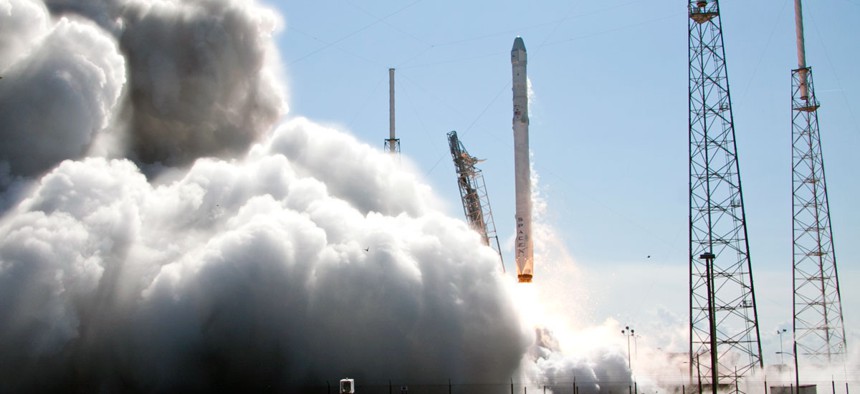SpaceX’s Mission Today Tested if it Can Protect Astronauts on its Spaceship

The Falcon 9 SpaceX rocket lifts off from launch complex 40 at the Cape Canaveral Air Force Station in Cape Canaveral, Fla. John Raoux/AP
SpaceX has to prove it can get astronauts away from its rocket as fast as possible in the event of an emergency.
Astronauts frequently compare riding a rocket to sitting on top of a bomb.
Given how badly things can go wrong with the kind of controlled explosion needed to break free of gravity, it’s easy to sympathize with their point of view, especially when everyone else watching the launch is at a safe distance.
That’s why SpaceX has to prove it can get astronauts away from its rocket as fast as possible in the event of an emergency. Here’s what that looks like:
SpaceX is competing with Boeing to become the first private company to take humans into space. May 6 marked its next big test: pad abort. In this unmanned mission, SpaceX demonstrated that its space capsule, the Dragon 2, can fly into the air on its own accord and parachute to safety, away from the Falcon 9 rocket that would otherwise carry it to orbit if it weren’t, you know, exploding.
The capsule is designed for this kind of safety maneuver: It boasts eight SuperDraco rocket engines around the body. The engines are among first built and flown with 3D printed components, part of the pursuit of cheaper, more efficient manufacturing processes that have defined SpaceX—and are coming to define its competitors, as well.
During the test, the Dragon 2 was mounted on a Cape Canaveral launch pad, and the following sequence occurred in just over 90 seconds:

It looked something like this pad abort test of the new NASA space capsule, Orion, which is expected to come into service a year after Dragon 2:
NASA previously selected SpaceX and Boeing to compete to become the first private companies offering space travel. To get there, they need to pass a series of tests. In this one, the passenger will a crash-test dummy with as-yet unidentified features, designed to measure the g-forces that astronauts may be subjected to.
The intent of the exercise, per NASA and SpaceX, is simply to gather more data on the craft’s performance in a real flight situation.
“The point is to gather data—you don’t have to have a flawless test to be successful,” NASA’s SpaceX program manager Jon Cowart said. The next milestone for SpaceX will be testing these same systems to show that the Dragon 2 can also escape from the Falcon 9 rocket while in flight.
The test indicates how much higher the stakes are becoming for SpaceX. It’s a significant accomplishment to send robotic ships to supply the International Space Station, but when that goes wrong—as in the calamitous failure of Orbital Science’s 2014 re-supply mission—the only damages are to reputation and insurance company bottom lines. The consequences would of course be far more severe with a crew of up to seven people on board.
NEXT STORY: CNN and FAA Team Up to Test Drones






